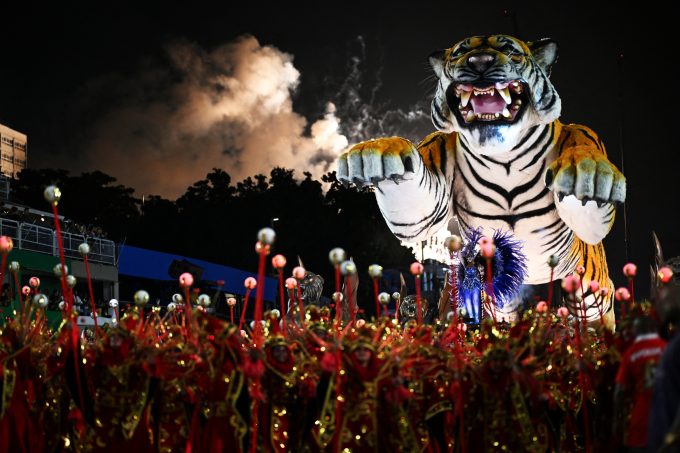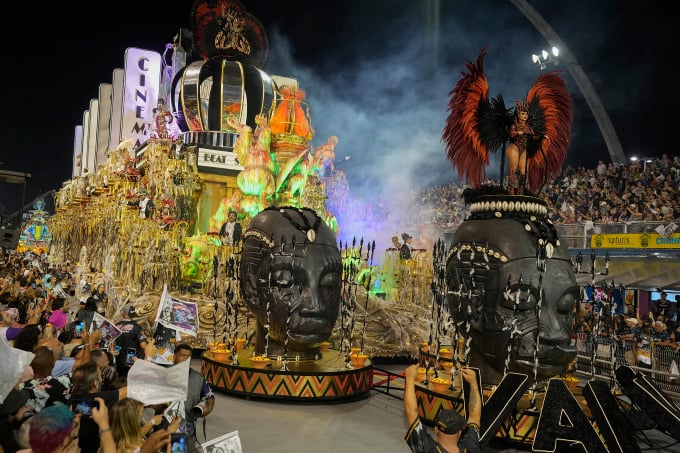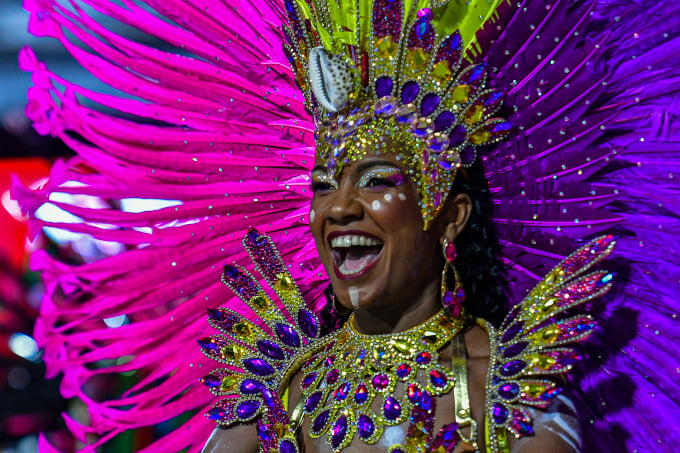Thousands of performers in colorful costumes dance to the rhythm of samba in the famous carnival parade in the coastal city of Rio de Janeiro.
On February 11, Rio de Janeiro held a carnival parade, with many colorfully decorated floats and performers wearing colorful costumes from 12 samba schools in the city dancing to the beat of drums, competing for the title of carnival champion.
Porto da Pedra, a samba school in the low-income Sao Goncalo neighborhood, opened the festival with a giant, growling tiger float, exciting tourists and festival-goers.
Debora Moraes de Souza, a 53-year-old doctor who grew up in Sao Goncalo, has been marching in the school carnival for nearly a decade. Every time he walks to the parade site, he gets goosebumps.
"The car went all the way down the street and people were like, 'That's it? I want more!'. Everyone was dancing, everyone was happy," the doctor said.

A tiger float from the Porto da Pedra samba school at the carnival in Brazil, February 11. Photo: AFP
The coastal city of Rio has been celebrating Carnival for weeks, with free, colorful street parties, or "blocos." The February 11 parade is the culmination of sound and color, lasting all night.
This year's parade took place at the Sambadrome stadium. The grandstands, which can hold 70,000 spectators, were packed. Each samba school took 60-70 minutes to use its floats to travel the 700-meter route. Millions of Brazilians watched the event live on TV.
The parade is about more than just partying all night.
In the stands, spectators wear colorful costumes, according to the colors of the samba school they support. The parades are often themed around a story related to politics, history and social issues.
This year, Rio marked the occasion with parades themed after historical heroes, the Yanomami indigenous people, who have been devastated by illegal gold mining in the Amazon rainforest.
This year's Carnival is expected to bring in more than $1 billion in revenue for Rio. Other major cities in Brazil also hold parades, including Sao Paulo.

The Vai-Vai samba school parades in Sao Paulo, Brazil, February 10. Photo: AP
Born a century ago by descendants of African slaves, samba is one of Brazil's pop culture icons.
Organizing a parade with more than 3,000 samba dancers and a huge fleet of floats is no easy task. Samba schools spend a year preparing and often compete fiercely for the championship title.
"It's always a last-minute rush to make sure everything looks 'cool,'" said 43-year-old restaurant owner Priscilla Frota, as she adjusted her outfit.
Across the street, Marina Oliveira, 35, takes a selfie in front of the flower-covered float she designed for the Salgueiro samba school. “It has a feminine power, made entirely by women,” she says.
Meanwhile, Alexandre Reis, a 52-year-old electrical engineer, was rushing to fix a last-minute problem when the lights on one side of the float failed. Reis has handled such emergencies at the carnival for the past 23 years.
"This is a complex job. Lighting requires a lot of technical expertise. I do this from the heart, we pour blood and sweat because we love these samba schools," he said.

Samba dancers dance at the carnival in Rio de Janeiro, Brazil, February 10. Photo: Reuters
Duc Trung (According to AFP )
Source link


![[Photo] Looking back at the impressive moments of the Vietnamese rescue team in Myanmar](https://vstatic.vietnam.vn/vietnam/resource/IMAGE/2025/4/11/5623ca902a934e19b604c718265249d0)


![[Photo] "Beauties" participate in the parade rehearsal at Bien Hoa airport](https://vstatic.vietnam.vn/vietnam/resource/IMAGE/2025/4/11/155502af3384431e918de0e2e585d13a)



























![[Photo] Summary of parade practice in preparation for the April 30th celebration](https://vstatic.vietnam.vn/vietnam/resource/IMAGE/2025/4/11/78cfee0f2cc045b387ff1a4362b5950f)


























































Comment (0)